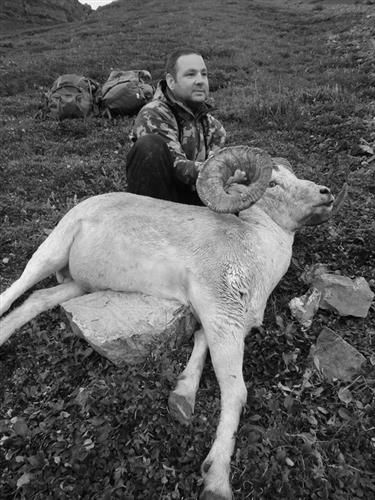Ovis Dallis
Those of us who have lived with a fascination for wildlife all our life seldom forget the first time we spotted a certain species in the wild. I can easily recall the 18 or so Dall sheep near the head of the South Fork of Montana Creek, sticking out like so many glittering rocks among the greens, and grays of the slope on my left. I was following along behind Ben Stevenson on a walk from Talkeetna into the Sheep River valley, and I was dead tired, but still caught up in the moment of new discovery. They were just lambs and ewes, but I had never seen Dall sheep before, so it was something to behold in my mind. The country had turned spectacular as we turned up into a narrow gorge in the head of the valley, and the sheep seemed to fit perfectly into the landscape. The memory remains vividly etched in my mind, even though I have seen way too many sheep to count since that time. It was probably the beginning of the addiction for me, and for those of you who have hunted sheep in the mountains, you know what I speak of.
Dall Sheep Habits and Habitat

Alaska Dall sheep typically live in the 2,500-6,500 ft. elevation range and they inhabit all of the major mountain ranges of the state, along with a few minor ranges. Dall sheep can be found from the edge of the Aleutian Range near Lake Clark, all the way to the Yukon Territory border in the east, and from there they flourish to the North Slope in the Brooks Range, well above the Arctic Circle. The well-known mountain ranges that Dall sheep inhabit are the Alaska Range, Brooks Range, the Wrangell Mountains, Chugach Mountains, and the Talkeetna Mountains. The Alaska Range rises just north of Cook Inlet (west of Anchorage) and swings some 350 miles north, northeast until it arrives near Tok. The Brooks Range stretches for over 500 miles, east to west, so one can see that we are not speaking of small ecosystems when we talk about sheep habitat in Alaska. All sheep country is similar inasmuch as it will always have an available supply of grasses and lichens, water, and inaccessibility. The inaccessible trait of sheep country is what makes sheep hunting different than most of the hunting in North America, and inaccessibility plays a key role in the development of trophy rams. Genetics also play a key role in the development of trophy rams, and some areas certainly rise above others when it comes to good genetics. The Chugach Mountains have been consistent when it comes to trophy ram production, and for this reason, it is the base for our sheep hunts. We also hunt the Talkeetnas and will hunt the Alaska Range if certain combination hunts are desired by the individual, but the Chugach certainly has our attention at this time. As with other hunting in Alaska, we try to remain flexible and work with what nature presents us, and sometimes the Alaska Department of Fish and Game dictates changes that alter the way we hunt, and even the locations we hunt.
Dall sheep usually remain in a rather small range for most of their lives, but they have been known to travel excessive distances from time to time. During the month of August, when sheep hunting starts in Alaska, most bands of sheep will be settled into a routine that is fairly predictable, and their travels will be quite limited. They are basically at rest in their “summer range.” Biologists have determined that lambs and ewes commonly have four ranges, while rams often use six particular ranges, although both sexes occasionally get by on two distinct ranges, summer and winter. It is almost a given that rams that summer in a particular range one year, will indeed return to this same range for the rest of their lives, and this predictability is something hunters have long depended on. Unlike caribou that often travel 25 miles in a day, and adult ram will seldom move more than a couple of miles in a day, at least not while he is un-pressured in his summer feeding grounds. Sheep usually spend several hours feeding each morning, only to retire around 10 AM to 12 Noon. It is not uncommon for a ram to bed for several hours at a time during such siestas, but it is common for one to arise, simply to nibble for 5 minutes, only to bed down again for an hour. Dall sheep essentially move when the stomach tells them to, and their tendency to bed for a decent amount of time is often to the advantage of the hunter. While sheep do take in a large amount of the moisture they need from the foods they digest, they do drink water, and during arid times in the mountains, their movements to watering holes can be predictable. Mineral licks are also used, but the tendency of a ram to remain in the same general vicinity, day after day, during the summer season is the primary habit that the hunter has to focus on. This being said, a given ram can and will disappear if it deems the pressure unacceptable, either from humans, or other predators, such as wolves.